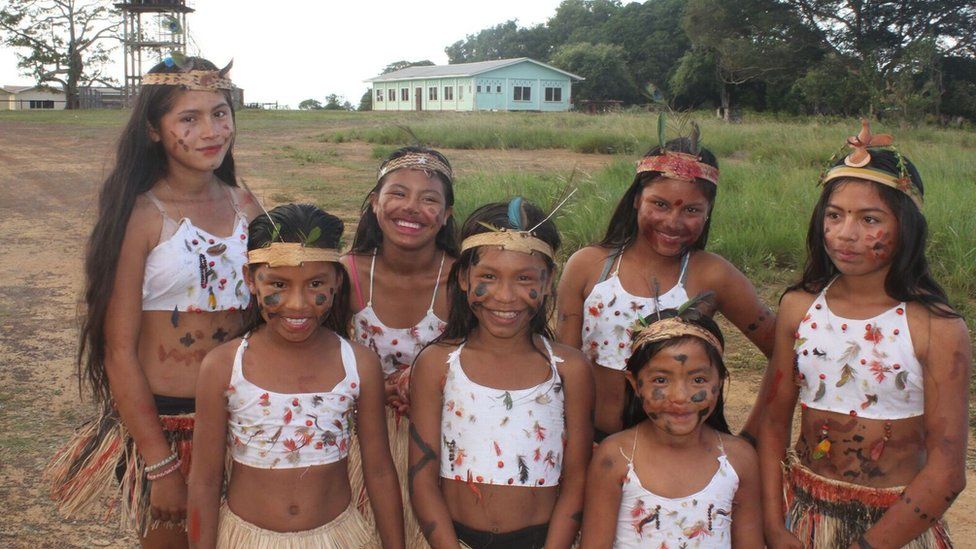The Guyana tribe in search of a lost identity
- Published

Painted on a classroom wall, high above the modest wooden benches and chalkboards, Moco-Moco primary school's motto reads: "Onward upward may we ever go".
It serves as a daily reminder that there are opportunities for those who apply themselves diligently at this tiny school of 81 pupils in a remote Amerindian village in Guyana.
Sometimes, though, the lack of modern teaching aids is a source of concern for long-time head-teacher Stephen Demetro.
"We have no internet and no computers, so we are at a disadvantage. It makes me feel guilty at national assessment time... we just don't have the resources," he said.
"Even the newspapers we get here can be a week late," he added, holding up a dated copy of the Stabroek News.
An isolated life
Home to 400 Macushi people - one of Guyana's nine Amerindian tribes - Moco-Moco is a sleepy conglomeration of traditional thatched-roof homes.
In this part of the Rupununi Savannah, scarlet macaws squawk from palm trees and tapir, deer and paca - which villagers still hunt using bows and arrows - roam wild.
Cassava crops, a staple food for millennia, fringe the settlement, which is linked to the nearest town by a long road dotted with potholes. On either side, giant termite mounds hold sway over the windswept plains like silent sentries.
Amerindians may have been the first people to inhabit Guyana and they still make up nearly a 10th of the six-race nation's population. But they are also among the country's most marginalised.
Sparse infrastructure and employment opportunities are obvious side-effects of life in isolated locations. Some say they are discriminated against as well.
Others describe a loss of identity, as a rich culture dating back 11,000 years is gradually eroded.
On top of that, there are increased threats to Amerindians' agrarian lifestyle from climate change, and encroachment on their historical land from the mining industry, a bulwark of Guyana's economy.
Thomas George, a former "Toshao" or village chief of Moco-Moco, says the lack of jobs drives "young brain-boxes" to the city, diminishing the community's strength.
One plan to combat that is the establishment of a cassava factory to create employment, along with saleable products made from the root vegetables such as tapioca, farine, a type of flour, and cassareep, a popular condiment.
But changing weather patterns pose a constant threat to agriculture. "When we expect sun we get rain, and when we expect rain we get sun. That affects food supplies," Mr George said.
"If the season changes and the floods come, it all goes down the drain."
Reviving a culture
Indigenous cuisine is something of a dying art in Moco-Moco, as are traditional crafts and even dialect.
A recently-opened youth centre aims to teach young Amerindians about their heritage, with classes on everything from the Macushi language to cooking pepperpot - an indigenous meat stew and Guyana's national dish.
"The school follows the national curriculum and that doesn't cater much to indigenous culture," Mr Demetro said. "It's up to teachers to find our own ways of integrating culture into it."
This year, nearly a billion Guyanese dollars (£4m) has been budgeted by the government for youth training programmes in 106 Amerindian communities across the country, according to Valerie Garrido-Lowe, the junior minister for indigenous people's affairs.
"Parents find it difficult to pay for basic items their children need in secondary school, so many pupils get despondent and leave," she said. "This money will support school dropouts, single parents and young adults who need a second chance in life."
In addition to remedial maths and English, and vocational skills like joinery, carpentry and dressmaking, participants will have the chance to learn about eco-tourism and hospitality in a bid to woo more visitors to Guyana's pristine hinterlands.
"It's about reviving our culture too," said Sydney Allicock, Guyana's first indigenous vice president. "Tourists are usually sympathetic to Amerindians and are interested in hearing our languages and being part of our activities. We want to share our ecosystem with them.
"This programme will help us teach them about jungle survival and traditional medicine; we'll take them hiking and birdwatching."
Mr Allicock says the government is also looking into renewable energy, like solar, wind and biogas, to lessen the impacts of global warming.
"We are seeing the effects in river levels, loss of wildlife, and trees losing their fruit because the temperature suddenly changes," he said. "From time immemorial, Amerindians have been the caretakers of the Earth, working alongside nature, yet we are the hardest hit by climate change."
- Published23 October 2016
- Published11 December 2023